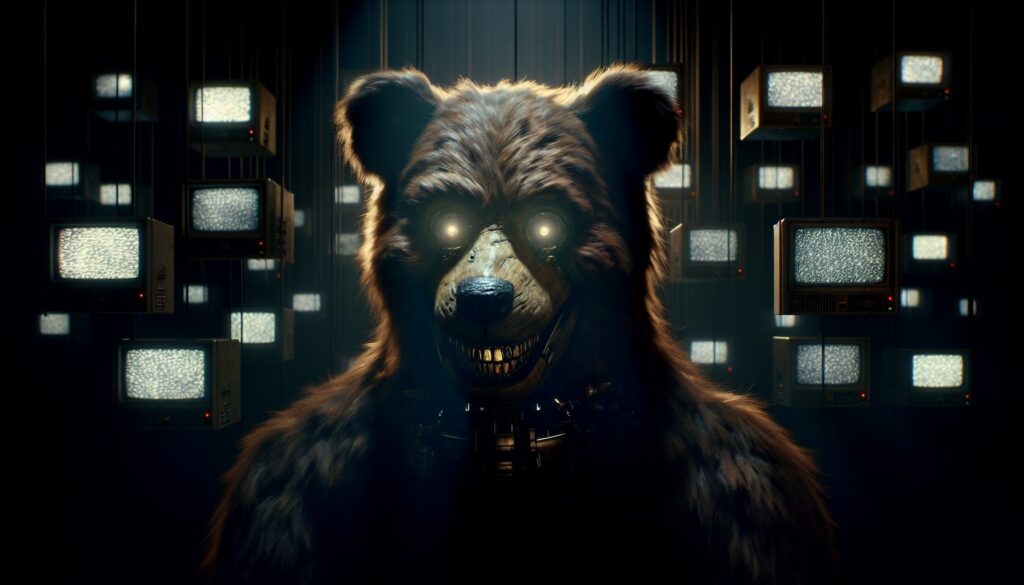”
I’ve always been fascinated by the eerie charm of animatronics, especially in the world of gaming. Five Nights at Freddy’s takes this fascination to a whole new level, blending horror and nostalgia in a way that keeps players on the edge of their seats. The animatronic characters aren’t just creepy; they’re integral to the game’s chilling atmosphere and storytelling.
As I dive into the mechanics and lore behind these iconic figures, I can’t help but appreciate how they’ve become cultural icons. From their unsettling designs to their unpredictable movements, these creations have left a lasting impact on both the gaming community and the horror genre. Join me as I explore the captivating world of animatronics in Five Nights at Freddy’s and uncover what makes them so unforgettable.
Key Takeaways
- Central Role of Animatronics: Animatronics in Five Nights at Freddy’s serve as both antagonists and essential elements that enhance the game’s horror atmosphere, creating a unique blend of nostalgia and suspense.
- Character Dynamics: Key characters like Freddy, Bonnie, Chica, Foxy, and Golden Freddy exhibit distinct behaviors and designs that contribute to their unpredictability and the overall tension experienced by players.
- Gameplay Mechanics: Players must utilize surveillance and strategic resource management to survive encounters with animatronics, leading to a thrilling and psychologically engaging gaming experience.
- Cultural Significance: The cultural impact of animatronics extends beyond the game, inspiring fan art, merchandise, and discussions that highlight their relevance in modern horror culture.
- Technological Evolution: Advancements in animatronic technology, from early 20th-century designs to modern innovations, have greatly influenced gaming experiences, making animatronics more lifelike and immersive.
- Adrenaline-Pumping Experience: The combination of unpredictable animatronic behavior and the necessity for quick decision-making creates a heightened sense of fear, keeping players engaged and on edge throughout their gameplay.
Animatronics:ilp3zklipfe= Five Nights at Freddy’s
Animatronics play a central role in Five Nights at Freddy’s, creating a unique blend of horror and nostalgia. These characters, modeled after classic children’s entertainment figures, serve as both antagonists and elements of suspense. Their unsettling designs contribute to a chilling atmosphere that keeps players on edge.
Key animatronics include:
- Freddy Fazbear: The mysterious mascot, embodying a warm yet threatening presence. Freddy’s movements bring tension as he approaches the player.
- Bonnie: A purple rabbit with a haunting smile, Bonnie embodies unpredictability, often appearing in surprising locations.
- Chica: The chicken animatronic carries a cupcake, combining cuteness with menace. Her pursuit of the player adds to the urgency.
- Foxy: A fox with a pirate theme, Foxy delivers a sense of impending doom. His rapid movements create a heightened sense of fear.
- Golden Freddy: This elusive character blurs the lines between reality and nightmare. Golden Freddy’s appearances heighten the game’s psychological horror.
These animatronics exhibit distinct behaviors, which enhance the gameplay experience. Players must monitor security cameras and manage limited resources to survive their relentless pursuit. The chilling atmosphere stems from their eerie movements and unsettling sounds, leaving a lasting impact on players.
The cultural significance of these animatronics extends beyond the game. Their memorable designs and unpredictable nature resonate within the horror genre, influencing various media forms. Through their haunting presence, animatronics in Five Nights at Freddy’s contribute to the series’ status as a landmark in horror gaming.
The Evolution of Animatronics
Animatronics, which blend robotics and artistry, have transformed over the years, especially within the gaming landscape. This evolution reveals intriguing layers of history and technological progress that enhance the experience of games like Five Nights at Freddy’s.
Historical Context
Animatronics trace their roots back to the early 20th century. In 1920, the famed magician Harry Houdini created an animatronic figure that captivated audiences. By the 1960s, Disneyland introduced sophisticated animatronic characters like the Enchanted Tiki Room’s singing birds. These early advancements established animatronics as a popular attraction in amusement parks. The combination of entertainment and technology became more pronounced in the 1980s and 1990s when Chuck E. Cheese’s brought animated characters into family dining. This era laid the groundwork for the animatronics seen today, blending fears and nostalgia, ultimately influencing the horror genre in gaming.
Technological Advancements
Technological progress has propelled animatronics to new heights, resulting in more lifelike movements and expressions. The introduction of servomotors and programmable logic controllers significantly enhanced mechanical precision and control. Modern animatronics utilize advanced materials like silicone and flexible electronics, allowing for more expressive features and smoother motions. In gaming, real-time animation techniques and artificial intelligence help create responsive and unpredictable behaviors in characters. The animatronics in Five Nights at Freddy’s benefit from these advancements, bringing each character’s personality and unsettling presence to life, intensifying the overall gaming experience.
Key Characters and Their Designs
The animatronic characters in animatronics:ilp3zklipfe= five nights at freddy’s present a blend of nostalgia and horror, each crafted with distinct designs and traits that contribute to the game’s chilling atmosphere.
Freddy Fazbear
Freddy Fazbear, the franchise’s mascot, features a brown bear design with a top hat and bowtie, projecting a mix of friendliness and menace. His design includes expressive eyes and a broad smile that contrasts with his threatening abilities. Freddy’s behavior revolves around blending into environments, making him unpredictable and forcing players to strategize their movements. As he approaches, the music box cues heighten tension, reinforcing his role as a primary antagonist.
Bonnie the Bunny
Bonnie the Bunny stands out with his vibrant purple coloring and prominent ears. His design emphasizes speed and agility, characterized by an unsettlingly wide grin. Bonnie’s unpredictability keeps players on guard, as he can swiftly navigate the pizzeria. His distinct behavior involves appearing suddenly in the player’s line of sight, making encounters tense. This combination of visual design and erratic movement creates a frightful gameplay experience.
Chica the Chicken
Chica the Chicken presents a yellow chicken design with a bib that reads animatronics:ilp3zklipfe= five nights at freddy’s . Her round shape and wide eyes lend a sense of cuteness that contrasts sharply with her ominous presence. Chica’s movements are more deliberate, and she exhibits a predilection for venturing into the kitchen. Players often hear her footsteps, which builds suspense as her design juxtaposes childlike innocence with a lurking threat, enhancing the horror ambiance.
Foxy the Pirate Fox
Foxy the Pirate Fox features a pirate-themed design, complete with an eyepatch and hook. His tattered appearance adds to his scary persona, reflecting a character with a troubled past. Known for his speed, Foxy typically remains hidden until he chooses to emerge, surprising players with his sudden attacks. This design, combined with erratic behavior, highlights his role as a significant threat, compelling players to remain vigilant.
Gameplay Mechanics Involving Animatronics
In Five Nights at Freddy’s, the gameplay mechanics center heavily on the animatronics, creating a suspenseful and strategic environment. Players must utilize surveillance systems to monitor these characters while formulating strategies for survival.
Surveillance and Strategy
Surveillance plays a critical role in gameplay. Players rely on security cameras to track animatronic movements throughout the pizzeria. Each camera provides unique insights, allowing me to anticipate potential encounters. I strategically toggle between feeds to gather crucial information while conserving power, a limited resource that adds another layer of tension. Understanding the behavior patterns of animatronics helps in developing effective defensive strategies. For instance, Freddy tends to move slower early in the night, while Bonnie and Chica exhibit more aggressive behaviors. I adjust my monitoring approach based on their movement, ensuring that I’m prepared for the unexpected.
Encountering Animatronics
Encountering animatronics heightens the horror experience. As I navigate through the gameplay, animatronics can appear suddenly in the player’s vicinity, triggering quick decision-making. Their distinctive sounds, such as Bonnie’s familiar guitar strum or Foxy’s rapid footsteps, indicate differing levels of threat. Each encounter demands immediate action, whether I’m closing doors, using lights, or managing my power effectively. The urgency and unpredictability of these interactions create a sense of dread and immersion. Players experience intense moments as we face the animatronics, which reinforces the game’s spine-chilling atmosphere and keeps me engaged in the thrilling survival aspect of Five Nights at Freddy’s.
The Impact of Animatronics on Horror Gaming
Animatronics significantly reshape the horror gaming landscape, particularly through games like Five Nights at Freddy’s. These characters mesmerize players, enhancing their engagement and deepening the overall chilling experience.
Player Experience
Player experience remains central to the impact of animatronics. Each encounter with characters like Freddy, Bonnie, and Chica creates a palpable tension that enhances immersion. Players monitor security cameras to track animatronics, making quick decisions when unexpected movements occur. Controlling resources like power adds another layer of challenge, as players balance survival with the constant threat presented by animatronics. This interaction fosters an adrenaline rush, compelling players to adopt distinct strategies to navigate the horror environment. The enhance gameplay is not just about mechanics; it’s a psychological journey through fear, suspense, and surprise that keeps players coming back for more.
Cultural Influence
Cultural influence extends beyond the confines of the game itself. The unsettling designs and behavior of animatronics have inspired a wave of merchandise, fan art, and online discussions. The unique aesthetic qualities of characters like Foxy and Golden Freddy resonate with creators across various media, including films and literature, showcasing their significance in modern horror culture. Additionally, the animatronics’ lore has sparked dedicated communities and theories, contributing to an ongoing dialogue about the franchise’s themes of fear and nostalgia. This cultural impact highlights the unique intersection of horror and animatronics, cementing their role as iconic elements that continue to captivate audiences worldwide.
The world of animatronics in Five Nights at Freddy’s is a fascinating blend of horror and nostalgia that captivates players. Each character brings a unique element to the gameplay experience that keeps me on the edge of my seat. The strategic monitoring of these unsettling figures adds layers of tension and excitement that are hard to forget.
The cultural impact of these animatronics extends far beyond the game itself. They’ve inspired a vibrant community that thrives on creativity and discussion. As I reflect on my experiences with these characters, I can’t help but appreciate how they’ve shaped the horror genre and gaming culture as a whole. The legacy of Five Nights at Freddy’s continues to grow, making animatronics an enduring symbol of fear and fascination.

